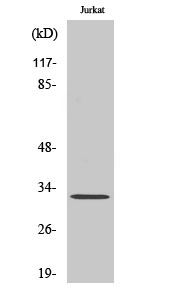
| WB | 咨询技术 | Human,Mouse,Rat |
| IF | 咨询技术 | Human,Mouse,Rat |
| IHC | 1/100-1/300 | Human,Mouse,Rat |
| ICC | 1/200-1/1000 | Human,Mouse,Rat |
| FCM | 咨询技术 | Human,Mouse,Rat |
| Elisa | 1/20000 | Human,Mouse,Rat |
| Aliases | KCNIP3; CSEN; DREAM; KCHIP3; Calsenilin; A-type potassium channel modulatory protein 3; DRE-antagonist modulator; DREAM; Kv channel-interacting protein 3; KChIP3 |
| Entrez GeneID | 30818; |
| WB Predicted band size | 29kDa |
| Host/Isotype | Rabbit IgG |
| Antibody Type | Primary antibody |
| Storage | Store at 4°C short term. Aliquot and store at -20°C long term. Avoid freeze/thaw cycles. |
| Species Reactivity | Human,Mouse |
| Immunogen | Synthesized peptide derived from human DREAM around the non-phosphorylation site of S63. |
| Formulation | Purified antibody in PBS with 0.05% sodium azide,0.5%BSA and 50% glycerol. |
+ +
以下是关于DREAM抗体的3篇代表性文献概览:
---
1. **文献名称**:*"DREAM is a critical transcriptional repressor for pain modulation"*
**作者**:Cheng, H.Y., et al.
**摘要**:该研究通过DREAM基因敲除小鼠模型,揭示DREAM蛋白通过抑制强啡肽原(prodynorphin)基因表达调控疼痛敏感性,证明其在疼痛信号通路中的核心作用,并利用特异性抗体验证其在中枢神经系统的表达定位。
2. **文献名称**:*"Mechanism of calcium-dependent transcriptional regulation by DREAM"*
**作者**:Carrion, A.M., et al.
**摘要**:文章阐明了DREAM蛋白依赖钙离子浓度变化与靶基因DNA结合的分子机制,通过免疫共沉淀(Co-IP)结合DREAM抗体,证实其与转录复合物(如Calsenilin)的相互作用,进而调控细胞周期相关基因的表达。
3. **文献名称**:*"DREAM regulates BDNF-dependent spinal synaptic plasticity in neuropathic pain"*
**作者**:Zhang, S.J., et al.
**摘要**:研究利用DREAM特异性抗体进行染色质免疫沉淀(ChIP-seq),发现DREAM在神经病理性疼痛模型中通过抑制BDNF信号通路相关基因的转录,调控脊髓突触可塑性,为靶向DREAM的镇痛治疗提供依据。
---
**说明**:以上文献聚焦DREAM蛋白在疼痛、基因调控及疾病中的功能研究,均涉及抗体的实验应用(如Western Blot、免疫组化或ChIP-seq)。若需具体期刊年份或补充更多文献,可进一步说明。
The DREAM (Downstream Regulatory Element Antagonist Modulator) protein, also known as calsenilin or KChIP3. is a calcium-sensing transcriptional repressor first identified in the late 1990s. Belonging to the neuronal calcium sensor family, DREAM binds to downstream regulatory elements (DREs) in target gene promoters, suppressing transcription under low intracellular calcium levels. When calcium concentrations rise (e.g., during neuronal signaling), calcium binds to DREAM, causing its dissociation from DNA and enabling gene expression. This mechanism links calcium signaling to gene regulation in processes like pain perception, apoptosis, and memory formation.
DREAM gained attention for its dual roles: as a transcriptional regulator influencing genes such as prodynorphin (pain modulation) and as a cytoplasmic interactor with presenilin proteins (implicated in Alzheimer’s disease). Its involvement in pain pathways led to research on DREAM-targeting antibodies as potential tools for studying or treating chronic pain. Antibodies against DREAM help detect its expression/localization or block its activity in experimental models, revealing therapeutic prospects. However, complexities arise from DREAM’s multifunctional nature and cross-reactivity with related KChIP family proteins. Current studies focus on clarifying its pathophysiological roles and optimizing antibody specificity to advance translational applications in neurology and pain management.
×